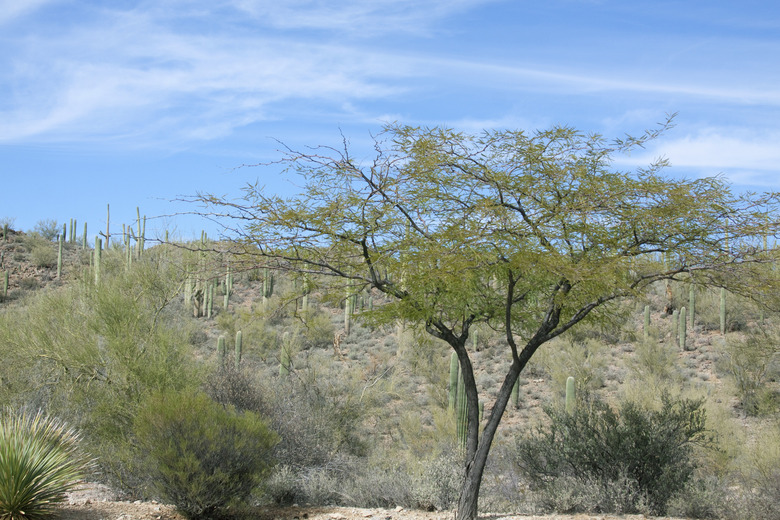Facts About The Chilean Mesquite Tree
Chilean mesquite trees (Prosopis chilensis and hybrids) dominate urban landscapes in the American Southwest. Hardy in U.S. Department of Agriculture plant hardiness zones 9 through 11, the trees woo homeowners with fast growth and graceful form. Also known as the thornless mesquite, Chilean mesquite brings fitting beauty to arid landscapes, but the South American native presents some challenges as well.
Growth Rate and Habit
In urban landscapes, Chilean mesquite trees outpace even their fast-growing, native relatives. The trees quickly establish themselves to grow 30 feet tall and wide, with spreading branches. The canopy's symmetry and dome-shaped silhouette fit well in formal landscapes, yet blend effortlessly into informal, native plantings. When the tree's rapid growth rate combines with urban irrigation and fertilizers, the tree can shoot to 50 feet in height and its aggressive roots take off. The quick growth results in weak branching, and roots wreak havoc with concrete and asphalt.
Favored Features
Even under intense desert sun and heat, Chilean mesquite provides ample shade. Each lacy, rich-green leaf holds up to 40 leaflets of 1/2 to 1 inch in length. Coupled with the tree's sinuous, dark-gray trunk, the result is refined and refreshing. Semi-evergreen foliage holds through warm winters, and then sheds as buds break in spring. In late spring, yellow-green catkins appear. Long, twisted seedpods follow and litter the ground as summer begins. Chilean mesquites should be thornless, but the trait is variable. Many trees surprise their owners with treacherous 3-inch thorns.
Irrigation Essentials
Chilean mesquites in urban landscapes generally require supplemental water, but frequent, shallow irrigation causes problems. The tree's naturally shallow roots stay close to the surface, and high-nitrogen turf fertilizers complicate things further. The oversize canopies disguise inadequate root systems. Without stable, deep, anchoring roots, the trees frequently topple when monsoon rains and winds hit each summer. This rarely happens with native mesquites. From the time of planting, encourage the tree's roots to grow deep. Deep, infrequent watering sends roots to lower levels and adds to Chilean mesquite's urban longevity.
Pruning Pointers
Reducing Chilean mesquite's canopy helps promote root development and balance. Remove about 20 percent of the tree's canopy each spring to encourage strong branching and increase resistance to high winds. Never remove more than 20 percent, or you may inhibit roots instead of encourage them. Wear heavy gloves, protective clothing and safety goggles when you prune mesquite, and watch out for errant thorns. Use sharp bypass loppers and a sharp pruning saw, and sterilize your blades with household disinfectant to prevent spreading disease.
Cultivar Confusion
Many trees offered for sale as thornless mesquites are hybrids of Chilean mesquite and other native and non-native mesquites. The different species cross readily, leaving a botanical jumble in their wake. Trees grown from seeds may be any mix of neighboring mesquites, and the numerous seedlings that arise from your tree will not grow true to the parent tree's qualities. To ensure a new Chilean mesquite has the features you desire, including the absence of thorns, choose cultivars grown from cuttings.
